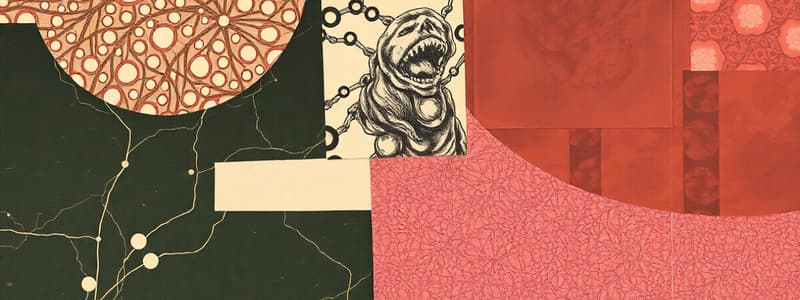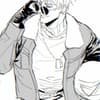Podcast
Questions and Answers
Which of the following best describes the role of fibroblasts in connective tissue?
Which of the following best describes the role of fibroblasts in connective tissue?
- They produce energy through ATP.
- They store nutrients for muscle cells.
- They transmit electrical impulses for communication.
- They produce collagen and elastin for tissue structure. (correct)
What is a consequence of excessive production of reactive oxygen species (ROS)?
What is a consequence of excessive production of reactive oxygen species (ROS)?
- Reduced inflammation in tissues.
- Oxidative stress leading to cell injury. (correct)
- Increased ATP production.
- Enhanced cellular repair mechanisms.
Which type of muscle tissue is under voluntary control?
Which type of muscle tissue is under voluntary control?
- Cardiac muscle.
- All types of muscle tissue.
- Skeletal muscle. (correct)
- Smooth muscle.
Which of the following factors does NOT influence the reversal of cellular injury?
Which of the following factors does NOT influence the reversal of cellular injury?
What occurs during the process of hypertrophy?
What occurs during the process of hypertrophy?
What is the primary role of antioxidants in relation to reactive oxygen species?
What is the primary role of antioxidants in relation to reactive oxygen species?
Which response is NOT typically associated with chronic cellular stress?
Which response is NOT typically associated with chronic cellular stress?
What is the correct order of the hierarchy of tissue organization?
What is the correct order of the hierarchy of tissue organization?
Which of the following accurately describes the extracellular matrix?
Which of the following accurately describes the extracellular matrix?
Which of the following is NOT a function of epithelial tissue?
Which of the following is NOT a function of epithelial tissue?
What role does collagen play in the extracellular matrix?
What role does collagen play in the extracellular matrix?
Which component of the extracellular matrix is responsible for providing tissue elasticity?
Which component of the extracellular matrix is responsible for providing tissue elasticity?
How do proteoglycans affect tissue properties?
How do proteoglycans affect tissue properties?
Which of the following is NOT a type of tissue mentioned?
Which of the following is NOT a type of tissue mentioned?
What is the main function of integrins in the extracellular matrix?
What is the main function of integrins in the extracellular matrix?
Flashcards are hidden until you start studying
Study Notes
Tissue Organization
- Tissues are organized in a hierarchical manner:
- Chemical level: Atoms combine to form molecules
- Cellular level: Cells are composed of various molecules.
- Tissue level: Composed of cells and their secreted extracellular matrix
- System level: Composed of different tissue types interacting to form organs and organ systems
- Extracellular matrix (ECM) is secreted by cells and influences tissue structure and function.
- In bone, ECM is hard and rigid.
- In tendons, ECM is stretchy and flexible.
- Key ECM molecules:
- Collagen: Provides strength and structure
- Elastin: Provides elasticity and stretchiness
- Proteoglycans: Fill space and attract water, determining tissue "softness" (e.g., cartilage).
- Integrins: "Glue" that connects cells to each other and to other ECM proteins.
Tissue Types
- Epithelial tissue:
- Functions: Protection, lining of organs, glandular secretion.
- Examples: Skin, cornea, lining of blood vessels and intestines.
- Connective tissue:
- Functions: Space filling, structural support, energy storage.
- Examples:
- Connective tissue proper (e.g., areolar tissue)
- Blood
- Cartilage
- Bone
- Ligaments
- Tendons.
- Fibroblasts are important for connective tissue:
- Produce collagen, elastin, etc.
- Involved in tissue healing and repair.
- Muscle tissue:
- Functions: Contraction to produce movement.
- Types:
- Skeletal (voluntary control)
- Smooth (involuntary control, lining organs)
- Cardiac (heart muscle)
- Nervous tissue:
- Functions: Transmission of electrical impulses for information transfer.
Cell Injury and Adaptation
-
Factors influencing cell injury reversal:
- Mechanism of injury
- Duration of injury
- Severity of injury
-
Free radical theory of cellular injury:
- Reactive oxygen species (ROS) are oxygen molecules with unpaired electrons.
- ROS can react with various molecules and form toxic chemicals, damaging cells and pathogens.
- Excess ROS production is called "oxidative stress" implicated in many disease processes.
- Oxidative stress can be caused by various factors like excessive exercise, radiation, tobacco smoke, and heat.
-
Antioxidants neutralize ROS, preventing DNA and cell damage.
- Endogenous antioxidants (e.g., glutathione, peroxidase, catalase) are produced by the body.
- Exogenous antioxidants (e.g., Vitamin C, E, beta-carotene) are obtained from the diet.
-
Exercise and free radicals:
- Exercise increases ROS formation acutely.
- This can impair muscle force production, but also triggers adaptive responses to increase endogenous antioxidant production and repair mechanisms.
- Excessive exercise can cause significant oxidative stress.
-
Genetic alterations causing cell injury/death:
- Alterations in chromosome structure or number: Examples: Down Syndrome
- Single gene mutations: Example: Sickle Cell Anemia
- Multiple gene mutations interacting with environmental factors: Examples: Type II Diabetes, Obesity.
-
Possible responses to physical stress:
- Decreased stress tolerance (atrophy)
- Maintenance
- Increased stress tolerance (hypertrophy, hyperplasia)
- Injury
- Death
-
Mechanical stressors initiating cellular response:
- Overstretch
- Compression
- Friction
Reversible Cell Injury
- Increased sodium and calcium influx into the cell
- Cell swelling
- Impaired organelle function (especially mitochondria, leading to decreased ATP production and cellular acidosis)
- Reversal is possible if:
- The nucleus remains undamaged.
- The energy source is restored.
- The toxic injury is neutralized.
- Reversal leads to the cell returning to its normal state of function.
Chronic Cellular Stress Responses
- Atrophy:
- Reduction in cell or organ size.
- Examples: Bone loss, muscle wasting, brain cell loss.
- Hypertrophy:
- Increase in cell size due to increased functional demands or hormonal input.
- Occurs primarily in cardiac and skeletal muscle, which cannot increase cell number.
- Example: Left ventricular hypertrophy due to exercise training or hypertension.
- Hyperplasia:
- Increase in cell number due to increased functional demands, hormonal stimulation, or physical stimulation.
- Often occurs alongside hypertrophy.
- Examples: Callus formation, thickened uterine wall lining, smooth muscle proliferation in diseases like obstructive airway diseases, prostate enlargement, and hypertension.
- Metaplasia:
- Change in cell morphology and function, converting one cell type into another.
- Example: Ciliated pseudostratified epithelium becoming squamous epithelium in smokers.
- Dysplasia:
- Increase in cell numbers with loss of morphology and tissue organization.
- Occurs in chronically injured areas undergoing hyperplasia or metaplasia.
Irreversible Cell Injury
- Cell death:
- Apoptosis: Genetically mediated, programmed cell death, with no inflammatory response.
- Necrosis: Active process of degrading dead cells involving nuclear and mitochondrial damage, lysosome release, and self-digestion of dead tissue, leading to inflammatory response.
- Contents of dead cells are released into the extracellular fluid and circulation, causing inflammation.
- Removal of necrotic tissue is needed for repair or regeneration
Studying That Suits You
Use AI to generate personalized quizzes and flashcards to suit your learning preferences.





